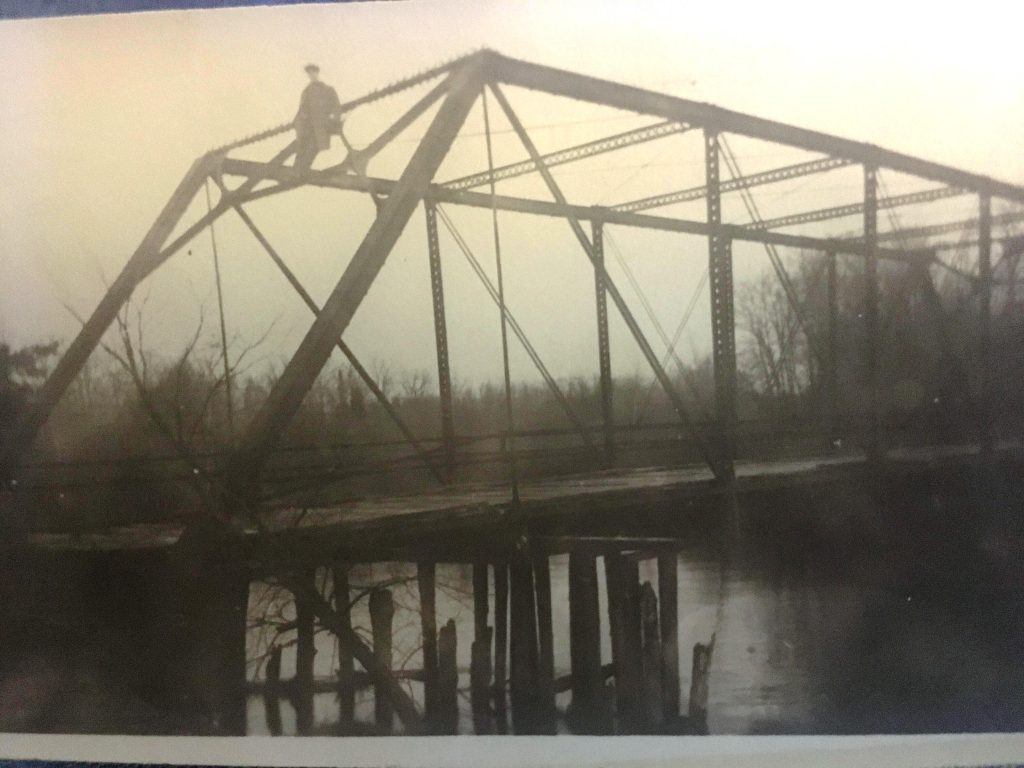
Carlos Goodrich Church Bridge ca 1910
We took a drive around Winterfield this week. The roads are dry, the countryside has greened, and almost every flowering tree and lilac in the township is blooming. Winterfield is showing off nicely this spring, not that she doesn’t at any other season. It was indeed a good day to take our long-time, local history loving friend, Andy Coulson, of the Clare County Historical Society, on a tour of our part of the county and share what we could of Winterfield’s story.
As I’ve mentioned before, Winterfield Township is a bit of an orphan in Clare County. We are township number one of the sixteen townships in Clare County, and last alphabetically. We are last in every plat book and county listing, too. We adjoin Osceola and Missaukee counties in our northwest corner, not only geographically, but in a variety of other ways, including economic, mailing addresses, area codes, fire protection and family connections.
Winterfield has not had any sort of ‘village’ in more than 100 years. That means that we have not had a store of any kind, for our convenience, in a very long time. Our last school, Grandon, consolidated with Marion in 1964. We have more permanent residents than we did fifty years ago, fewer small farms, and more acreage owned by summer and seasonal folks, i.e., non residents.
On the other hand, we have farms still owned by the same families and still productive. At least four of these are centennial farms, owned within the same family for one hundred years or more. Most of us who call this home are not farmers. Some residents live here and work in the Marion area, or beyond. Many consider it worth the drive, no matter what that may be. Many live here because their parents or grandparents did. We all live here because we think it is the best place to be.
Winterfield has a split personality. It is divided by our rivers. The Clam River enters from the north, and its western branch, joins it in Section 22. They meet the mighty Muskegon in Section 26. The Muskegon enters the township on its Summerfield boundary about midway to the east. These waterways served to move hundreds of thousands of logs during the lumber boom. Today they float hundreds of canoes, kayaks, tubes and their occupants, summer through fall. Everyone has a favorite high bank or camp somewhere along its course through Winterfield.
The rivers also split Winterfield’s land types. The farms are all on the western side of the township. On the east, are the scrub oak and Pine Barrens, today home to Jack pine ‘farming’ and the Kirtland’s Warbler. Both like the poor soil terrain and hot, dry summers. Farms on the west side of the rivers grow fine crops of corn, hay and in recent years, canola.
The rivers and their sprawl into Winterfield, have historically also added to our distance from Harrison, Clare and the eastern part of the county, and tightened our bond with Marion. In Winterfield there is only one Muskegon River bridge. This old crossing, located on Pine Road, was made by a raft for years and replaced by the first Church Bridge around the turn of the last century. There are at least seven Clam River bridges within our township, including the infamous ‘bridge to nowhere’.
Our tour included the former school sites, and the places known as Austa, Winterfield and Grandon. We showed off old home sites and current homesteads. We drove by the cemetery, where Winterfield pioneers, their descendants and new residents, alike, rest. We proudly showed off our one hundred year old township hall and told its story.
In hindsight, these things are only the basics, and not nearly all of them. As far as this goes to try and explain us, it does not define us or Winterfield’s past or present and certainly not our future. While we think we live in a place where things do not change, they have and they will. We can only hope that someday, if we’re well remembered, someone may point out our places and tell our Winterfield stories.
I think we need to give Andy a Winterfield tour part two. We have a lot more and we are a lot more than I gave us credit.
This week’s photo is of the original Church Bridge, an iron structure that spanned the Muskegon River on Pine Road for more than 60 years. Early resident Carlos Goodrich, who lived nearby, sits atop the span. We have to say that the construction looks like it was done with a big erector set.
